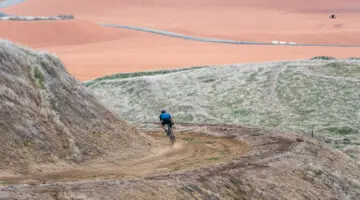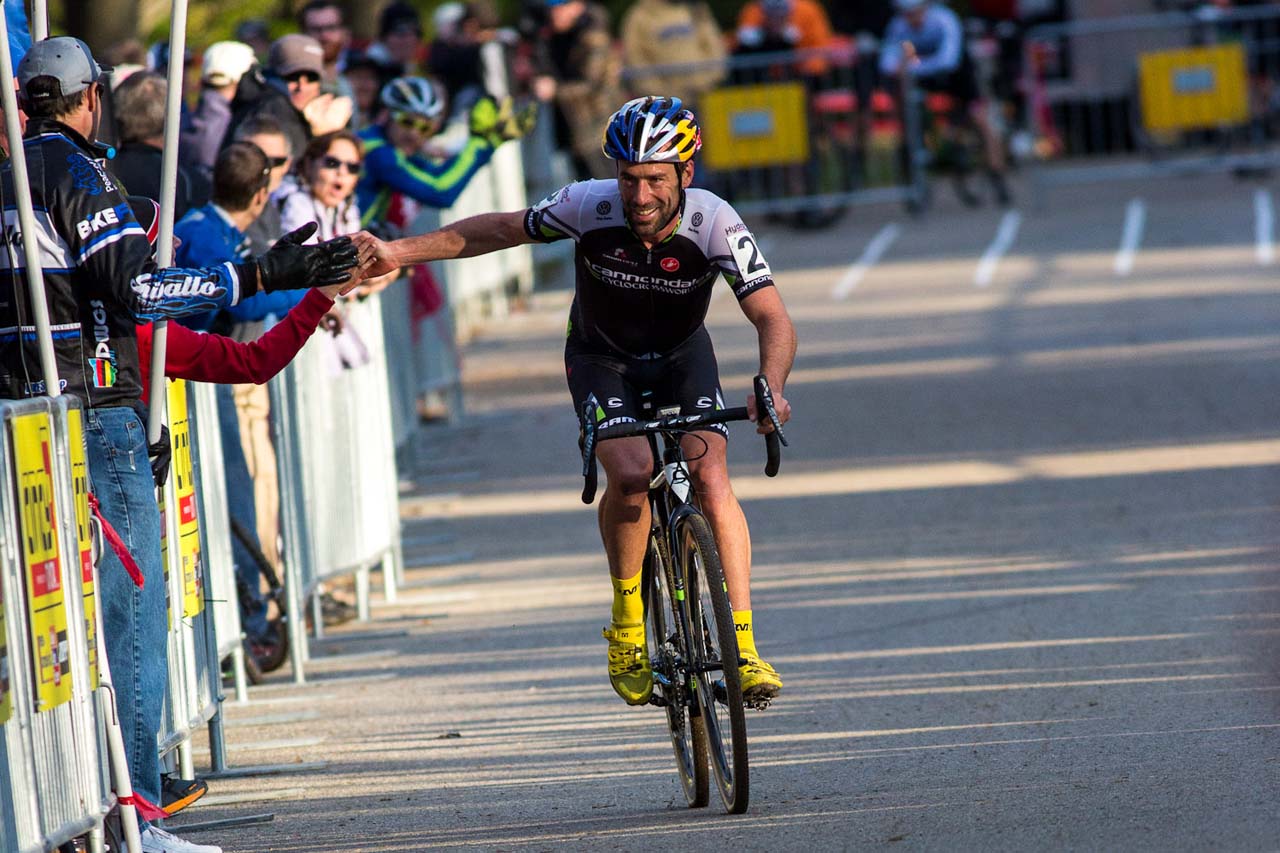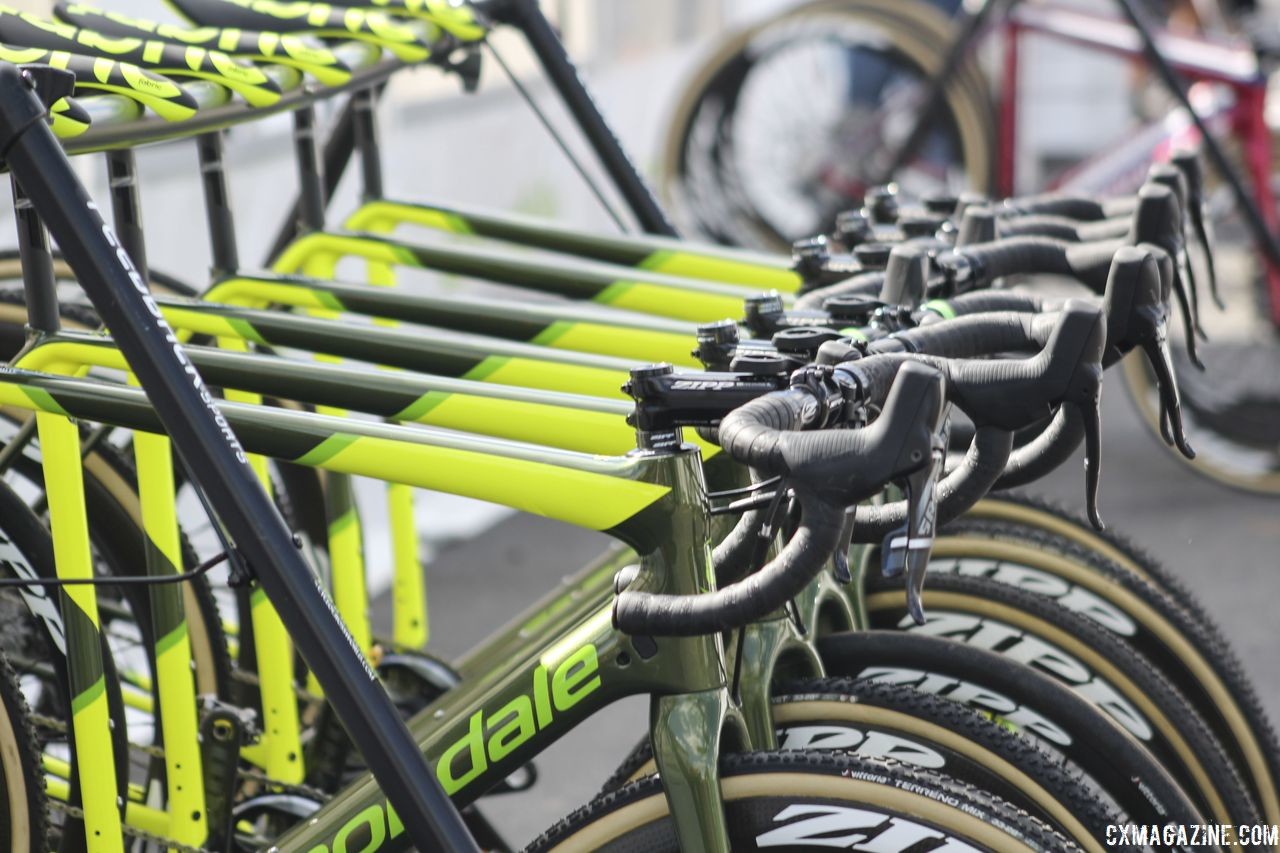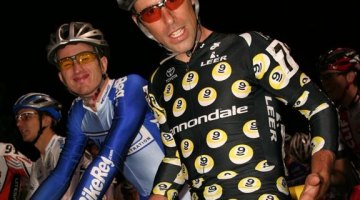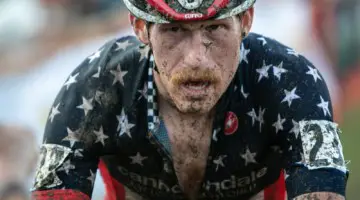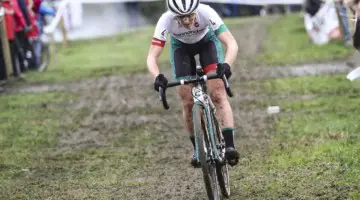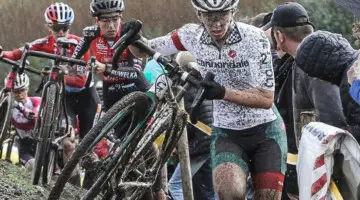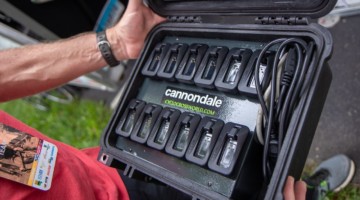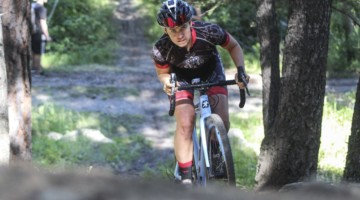Cycling is a sport where things are always in flux. Races come and go, teams change sponsors, riders move around.
The same is true of cyclocross in the U.S. However, during the past decade-plus of American cyclocross, two things have remained constant. One is Katie Compton in the Stars-and-Stripes.
The other is the can’t-miss green kits of the Cannondale p/b CyclocrossWorld team. Officially started in 2006, the Cannondale p/b CyclocrossWorld team is the longest-running, most successful U.S. cyclocross team.
Not surprisingly, the team’s roster has included a who’s who of U.S. racers. Tim Johnson, Jeremy Powers, Lyne Bassette, Ryan Trebon, Kaitie Keough, Ben Jacques-Maynes, Stephen Hyde, Jamey Driscoll, Maghalie Rochette, Emma White, the list of elite athletes who have come through the program goes on.
Stu Thorne started the program in the mid-2000s and continues to run it today. The team has had good relationships with key sponsors for that entire period. I wanted to know how the team managed to succeed and grow in a cyclocross landscape where teams come and go every year? Is there a secret formula to its longevity?
I headed inside the green tent for a look at the Cannondale p/b CyclocrossWorld program.
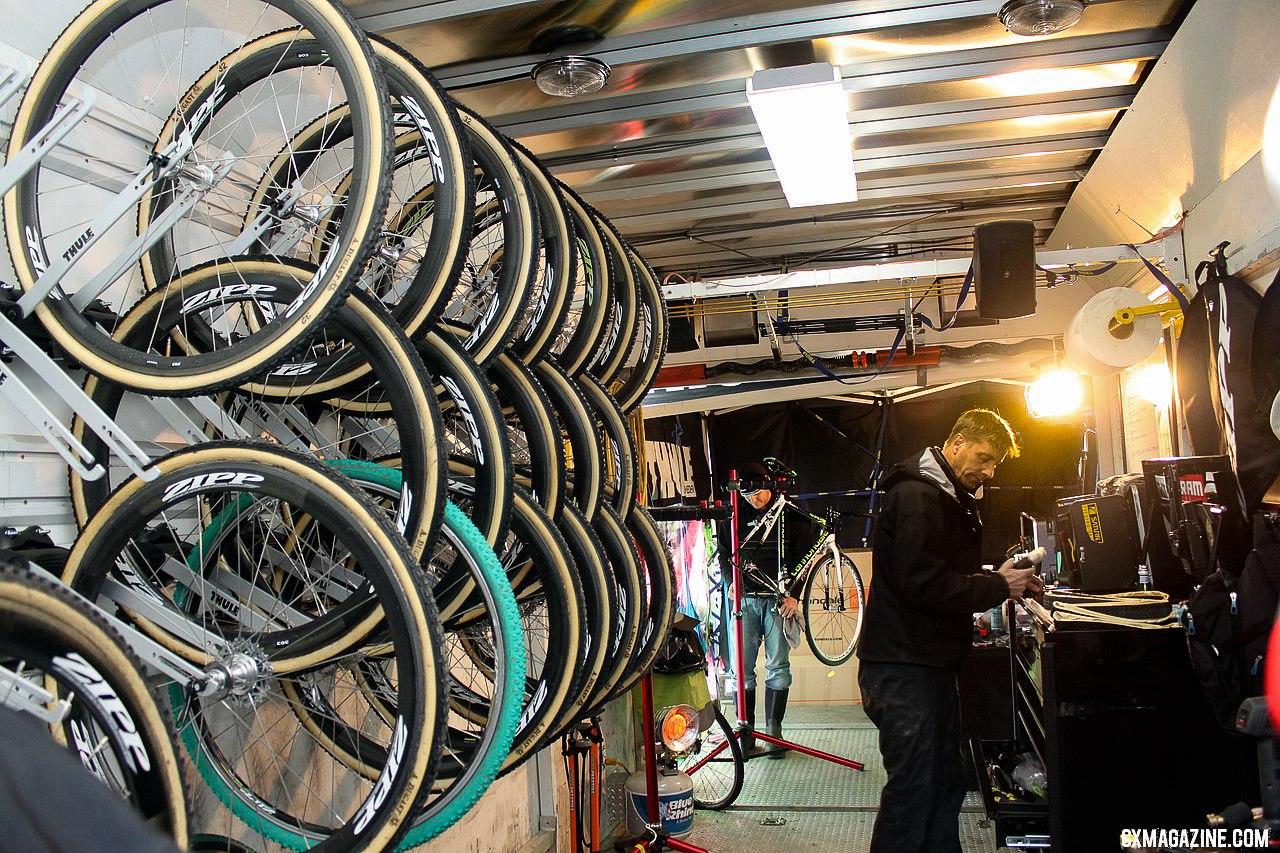
Stu Thorne has been working hard to keep the Cannondale p/b CyclocrossWolrd team rolling smoothly for as long as green Michelins were a thing. © A. Yee / Cyclocross Magazine
It Starts with Stu
With any team, there is a reluctance to give credit to any individual for its success. However, with the Cannondale p/b CyclocrossWorld program, it is impossible not to start with team owner and manager Stu Thorne.
“Stu knows his stuff. He’s been everywhere, he knows everyone,” team mechanic Mike Berry said about Thorne. “He is everything ’cross. He thinks about everything.”
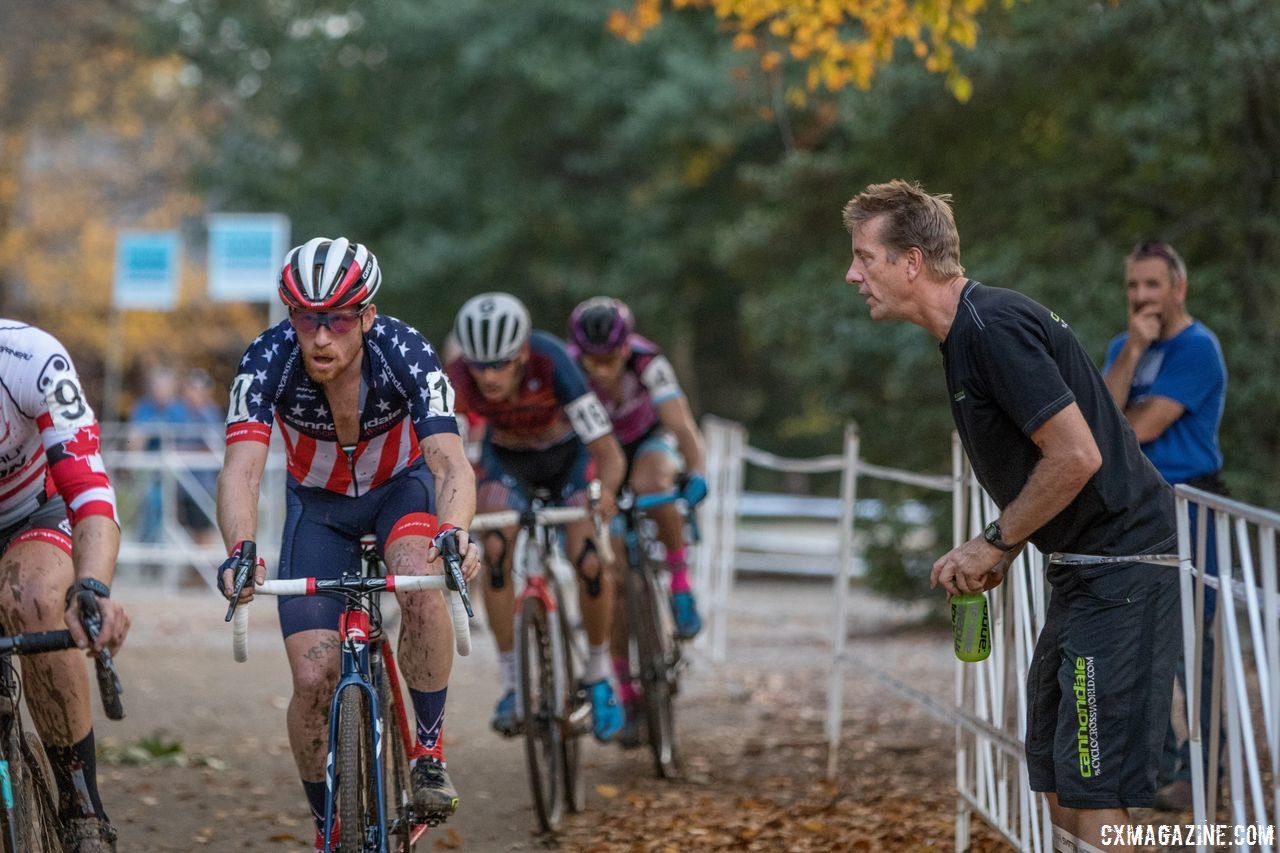
Under the guidance of Stu Thorne, the Cannondale p/b CyclocrossWorld program has been successful across the years. 2017 Pan-American Championships. © D. Perker / Cyclocross Magazine
“Stu has been in the cyclocross scene for so long, there really aren’t many people who have things more dialed than him,” long-time Cannondale p/b CyclocrossWorld rider Curtis White said. “He knows what works, and he prides himself in running a program that strives for excellence.”
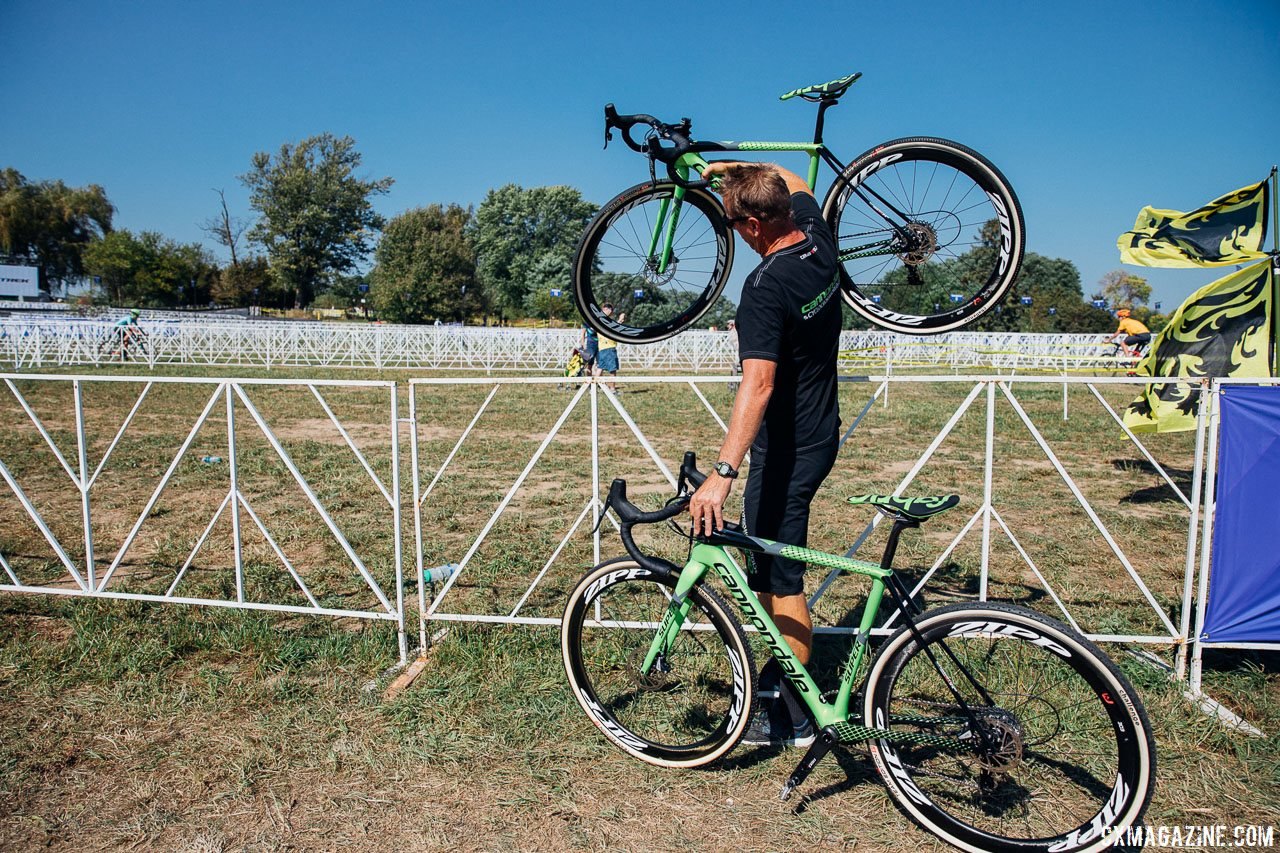
Stu Thorne supports the Cannondale p/b CyclocrossWorld team in many different ways. 2017 World Cup Waterloo © J. Curtes / Cyclocross Magazine
Stu Thorne grew up in Massachusetts and in his twenties was a relatively successful mountain biker. The story of how he discovered cyclocross is likely one you have heard before.
“I picked up a flyer somewhere talking about these ’cross races, and I was racing my mountain bike, so I was like, Well why don’t I go try this?” Thorne said. “Back then, lots of guys used a mountain bike. It was a rigid fork, skinnier tires and flat bars.”
“I just got hooked on it,” he continued. “It was like the coolest thing ever. It ran from October to Christmas time and it filled the void. I was totally into it at the time.”
Another key part of the program’s history is one of Thorne’s fellow New Englanders. Thorne has sponsored Tim Johnson’s racing career since the late 1990s, and the U.S. cyclocross legend continues to stay involved with the program in retirement.
Johnson and Thorne go way back to their younger days racing mountain bikes in New England. As it turns out, Tim Johnson, three-time U.S. cyclocross national champion and Worlds silver medalist might not have happened without Thorne. And as we also learned in our interview with new USAC Cyclocross Manager Jesse Anthony, he also would not have started racing ’cross if Johnson had not been successful.
“With Tim Johnson, in 1995 or ‘96 maybe, I knew Tim from mountain biking,” Thorne said. “I was like ‘Hey, you should try this ’cross practice.’ You should come try this thing. He blew everybody away, and he was a rock star. We were doing all kinds of skills and drills and he was the best there. That was the introduction to ‘cross for Tim.”
“Totally true,” Johnson said about Thorne’s story. “Upon returning home after taking a month abroad to travel after Junior Mountain Bike Worlds in September 1995, I popped into Stu’s shop to reminisce about the event. He’d been there watching and we hadn’t really known each other well until then. He asked what I was doing the next week and suggested I join him at a local ‘cross race. I said, ‘What’s ’cross?’”
At the time he introduced Johnson to cyclocross, Thorne was running a bike shop in Massachusetts. He quickly realized that being a talented racer was better left to his new friend. “I realized I wasn’t going to be a professional like these guys and doing Masters racing wasn’t really my thing,” he said.
Thorne’s thing at that time proved to be cyclocross, and as the 1990s came to a close, he took his passion for cyclocross into the business world.
The Team is Born
In the late 1990s, finding cyclocross equipment was a bit challenging. The sport was even more niche than it is now and the idea of most bike companies including a specific cyclocross line was well in the future.
Knowing the challenges but sensing an opportunity, Thorne launched cyclocrossworld.com, an online store for all things cyclocross.
One of the biggest challenges he faced in the early days was getting word out about his online store. The internet was not what it is today with targeted ads and social media platforms—and even a publication dedicated to cyclocross—so he needed to find a way to reach the folks likely to buy his ’cross-specific products.
“When I started Cyclocrossworld.com, the online store, we needed a way to market ourselves,” Thorne said. “I had helped out various riders in the past with product, and we supported events and things like that. We sponsored the USGP for a little while.”
He continued, “That kind of morphed into the whole official team thing. I had Jeremy Powers and Lyne Bessette and Tim riding for us. We worked all these different programs and it got bigger and bigger.”
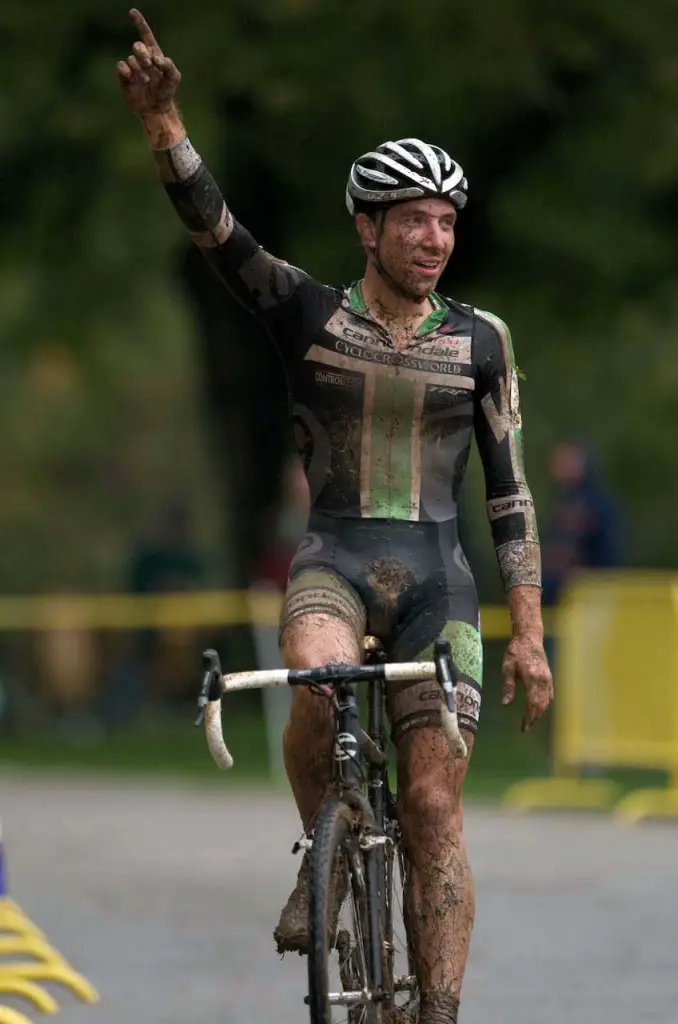
Jeremy Powers once raced for the Cannondale p/b CyclocrossWorld program. 2009 UCI3 Cyclocross Festival Day 1. © Mitch Clinton
In 2006 the small team of New Englanders locked in two sponsorships that have helped it grow into what it is today.
“Cannondale stepped in, and they’ve been a sponsor along with SRAM for 13 years now,” Thorne said. “I think in 2006, we kind of got more official with Cannondale, and the sponsorship was different. I would say that’s in the modern era, if you will.”
Even though the team became “official,” the intent of the program did not change from the earliest days with just a few riders. “So much of what we built with the team was based on the original idea that we were going to be a part of the sport and we wanted to go to events both here in the states and in Europe,” Johnson said.
He continued, “Being able to directly affect my own destiny as I moved away from racing on the road was huge. I was able to prove a business model that as a cyclocross athlete, with the right industry partners and support, you could make cyclocross a focus.”
Built to Last
Although the Cannondale p/b CyclocrossWorld team is now the largest single-team presence at North American cyclocross races, Thorne did not try to build a juggernaut right away. Thorne has managed the team’s growth in a careful fashion, making sure the resources are available to effectively support his riders and staff.
“I believe a lot in the longevity and sustainability of the program,” Thorne said. “Sometimes that comes with just managing what you have.”
The current roster now sports four Elite riders—Kaitie Keough, Stephen Hyde, Curtis White and Spencer Petrov—and seven Development team riders—Lizzy Gunsalus, Alex Morton, Magnus Sheffield, Sam Noel, Cooper Willsey, Lane Maher and Harrison White.
Team employees during cyclocross season are Mike Berry, mechanic and manager of the Devo program, Gary Wolff, mechanic for Keough and Hyde, and Rawny Semba, driver and mechanic for White and Petrov. The team will also staff up during big race weekends and to support athletes in Europe.
The amount of work Thorne and his team do behind the scenes is not lost on the riders in the program.
“There are a lot of time, energy, and resources that go into providing the right structure for athletes to not worry about anything else other than the race,” White said. “It’s far more complicated than it sounds, but Stu and the team manage to get it right. We have all the tools needed to succeed, the best mechanics and the best equipment.”
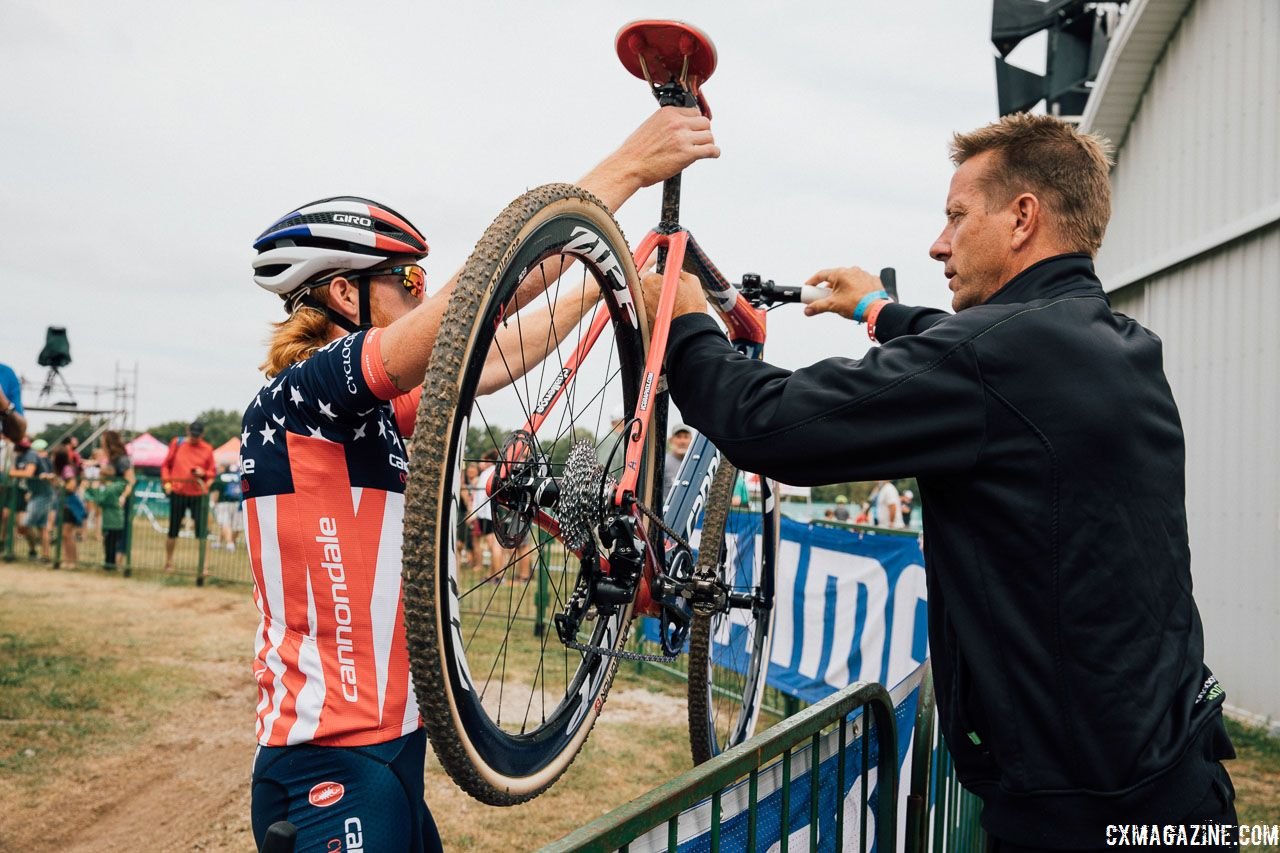
Stu Thorne and his team provide a lot of support for the program’s riders. 2017 Jingle Cross World Cup. © J. Curtes / Cyclocross Magazine
One notable thing about riders and staff in the Cannondale p/b CyclocrossWorld is they tend to stick around. No doubt one reason for the riders stay with the program is the support it can offer their cyclocross careers.
Berry said the cohesiveness of the program goes deeper. “It’s family, it really is,” he said. “They’re great people. You spend a lot of time with folks and they become like a brother or sister. You look out for each other, you’re always trying to help one another.”
White agreed. “Stu runs the best cyclocross program out there, and we love the atmosphere,” he said. “That’s all there is to it.”
Johnson’s continued involvement with the team is a sign of the strong bonds between Thorne, the riders and the team. He has been working with Thorne since the 1990s and continues to stay involved with the team where possible. On race weekends when Johnson is in town, you can bet he will make an appearance inside the green team tent.
“I was born into the New England bike racing family and couldn’t imagine walking away from a team that has become such a large part of my life,” Johnson said. “Stu, Emily and I built a team alongside a sport that was growing and changing over the last 23 years.”
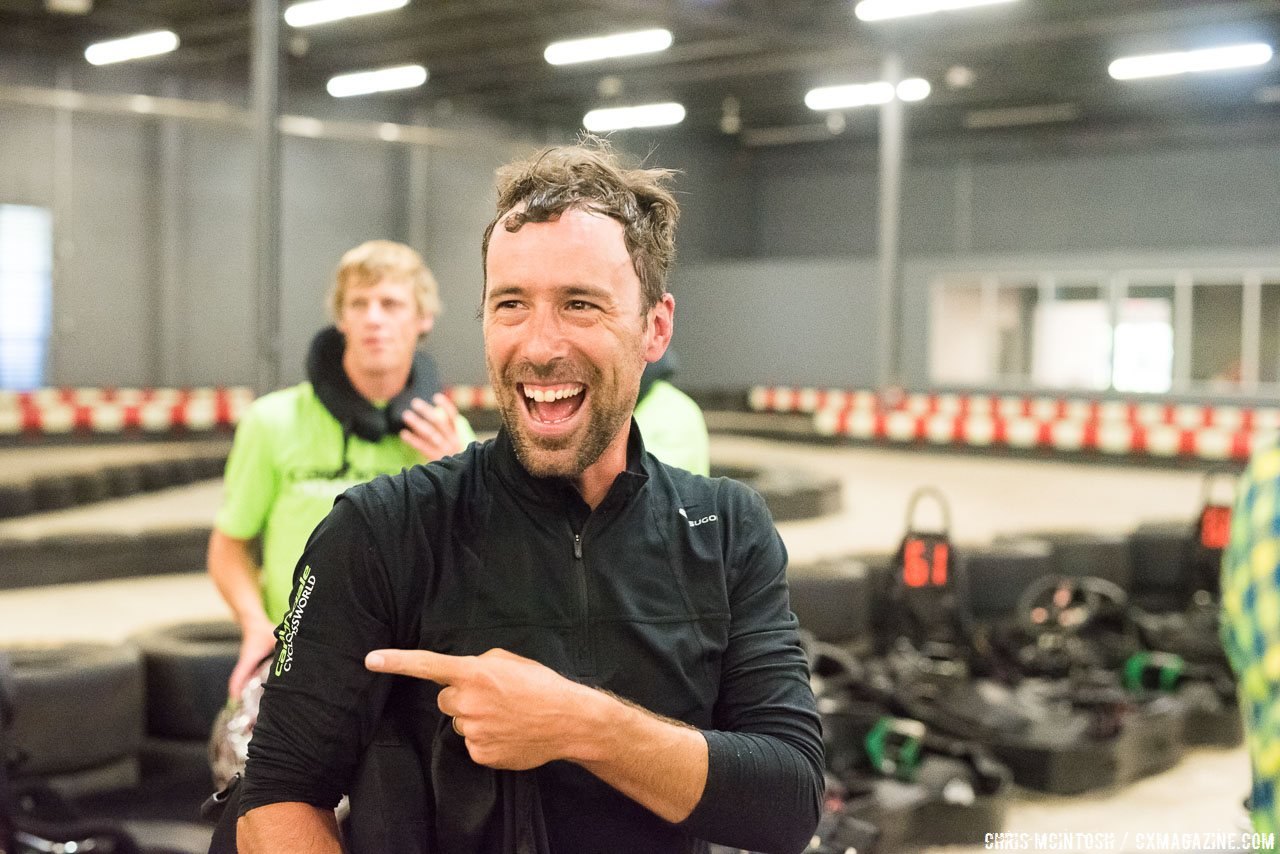
Tim Johnson has continued to stay involved with the team post-retirement. © Chris McIntosh / Cyclocross Magazine
The current pro team roster also demonstrates the stability and longevity Thorne hopes to see for his program.
Kaitie Keough first signed with the team in 2010 was she was just 18 years old. She has grown as an athlete with the program, and in 2017/18 had her most successful season as a cyclocross racer, finishing second in the World Cup overall.
“She was 18 when she started, total deer in the headlights,” Thorne said. “Tim and I were watching her race in Louisville when it was a USGP and we were like, who is this kid? She was really fast and fun, and she was just getting started. Kaitie is now the senior rider on the team.”
He added, “We thought her potential was something we could work with. To try to get her to grow into a rider who was second in the World Cup last year. To me, that’s all I could ever ask for. That’s a shining moment in what we do, to be able to see that progression is awesome. We love it.”
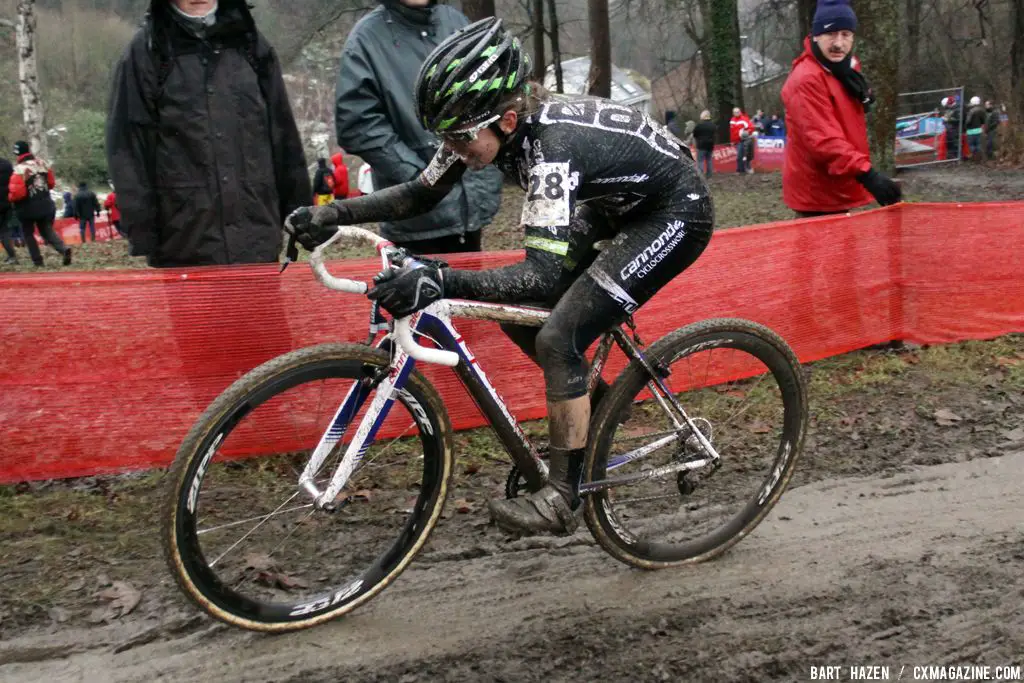
Kaitie Keough has been with the Cannondale p/b CyclocrossWorld program for a long time. 2011 Namur World Cup © Bart Hazen
Curtis White also signed with the team when he was 18. Now in his second year as an Elite, White has been with the program for six years and just had the best season of his cyclocross career, winning Pan-Ams and finished second at Elite Nationals.
Curtis followed in the footsteps of his sister Emma, who was with the team from 2012 through the end of the 2017/18 season. Their younger brother Harrison now rides for the Development team.
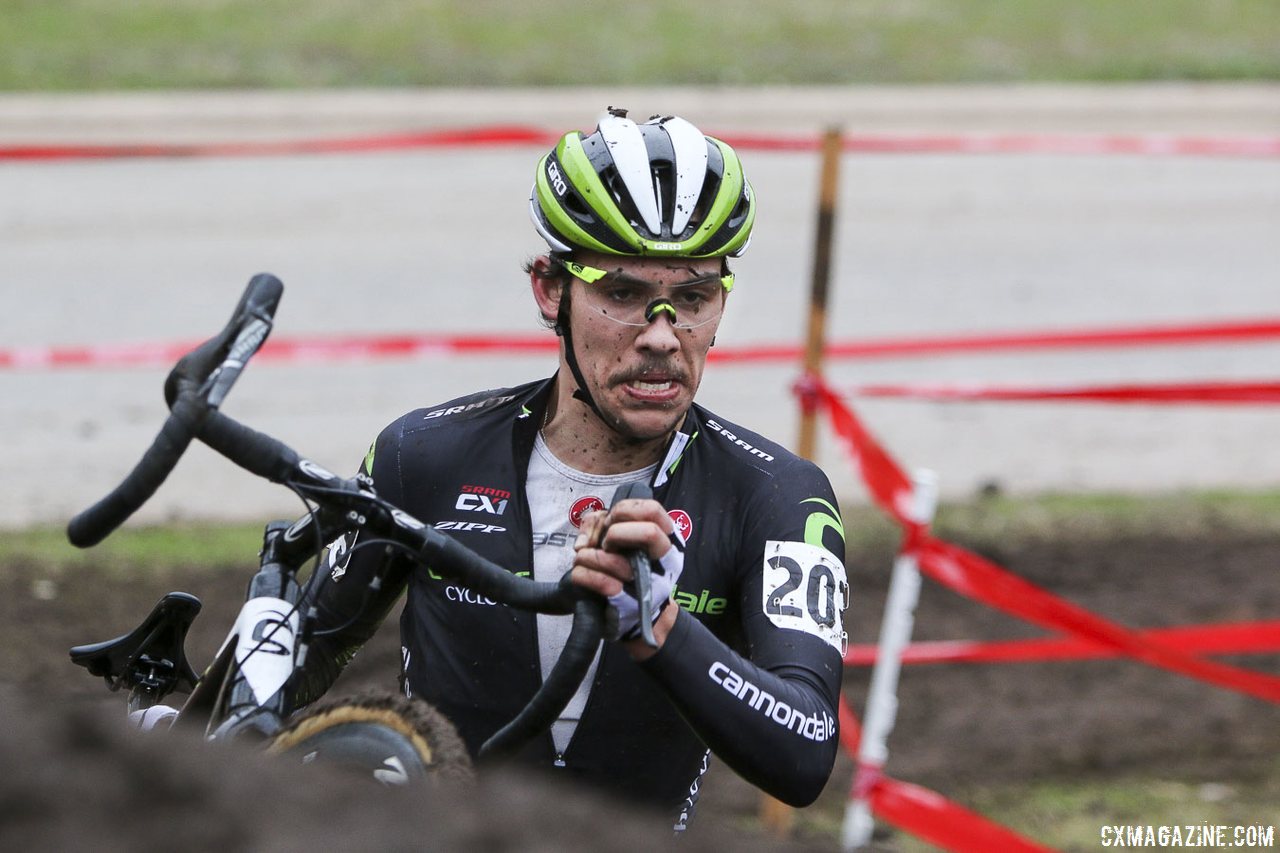
Curtis White has been with Thorne’s program since he was 18. 2015 U23 Cyclocross Nationals. © Cyclocross Magazine
Although he is only in his fourth season, Thorne sees a unique role for three-time national champion Stephen Hyde.
“In a short period of time, he’s gone from a guy who was primarily racing in New England to one of the best riders in the country,” Thorne said. “He’s got heaps of talent and is super thoughtful. He takes all his experiences and knowledge and shares it with all the other riders on the team. His progression has also been really great to watch.”
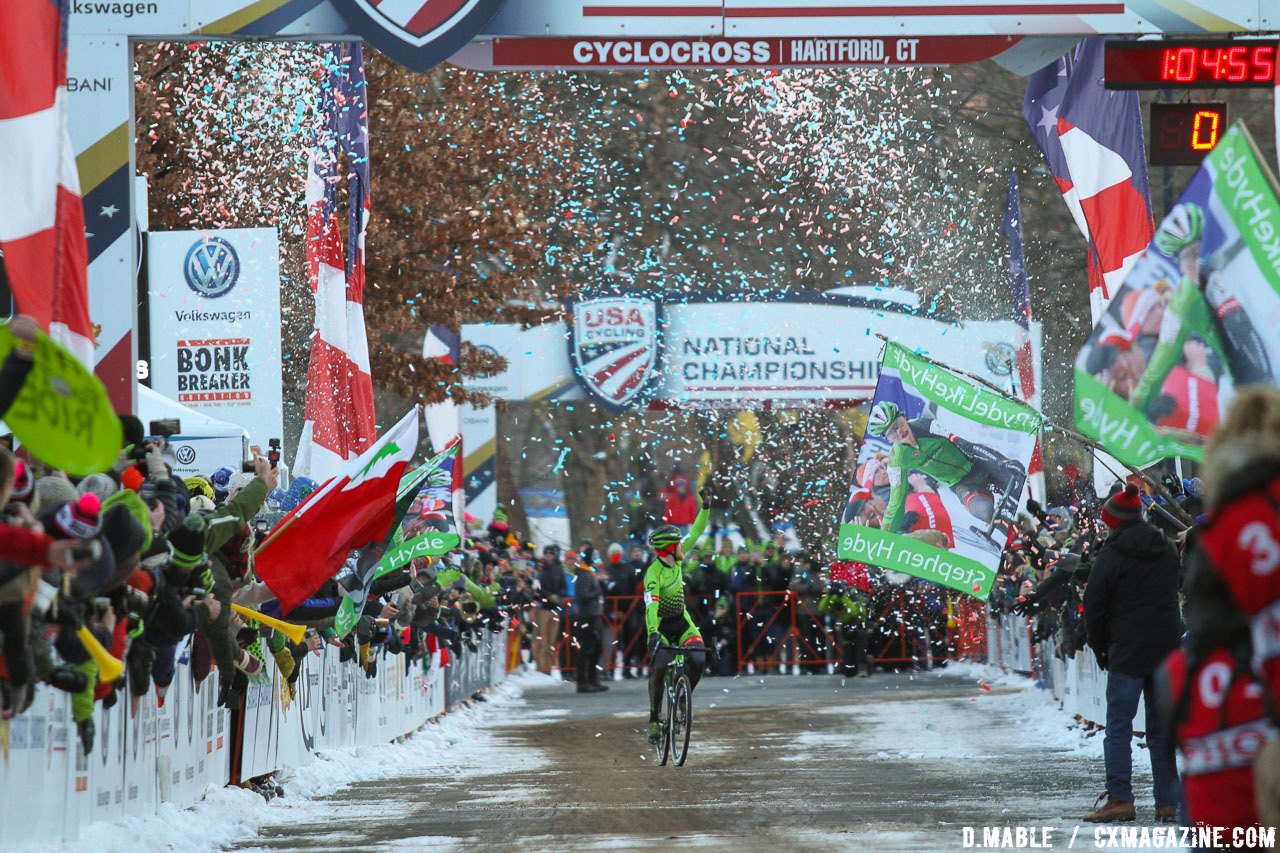
Stephen Hyde has won three national championships for the Cannondale p/b CyclocrossWorld team. 2017 Cyclocross National Championships, Elite Men. © D. Mable/ Cyclocross Magazine
The newcomer is Spencer Petrov, who was presented with the perfect opportunity when Emma White announced she was leaving cyclocross to focus on making the Olympic Track team. Petrov needed a team, the team needed a talented young rider.
“There were a good number of riders we thought about, but it came down to Spencer,” Thorne said at the beginning of the season. “I’ve known him for a while and watched him race in the U.S. and in Europe. He’s a great kid. He’s also shown his face at the front of a good number of Elite races and he’s still young.”
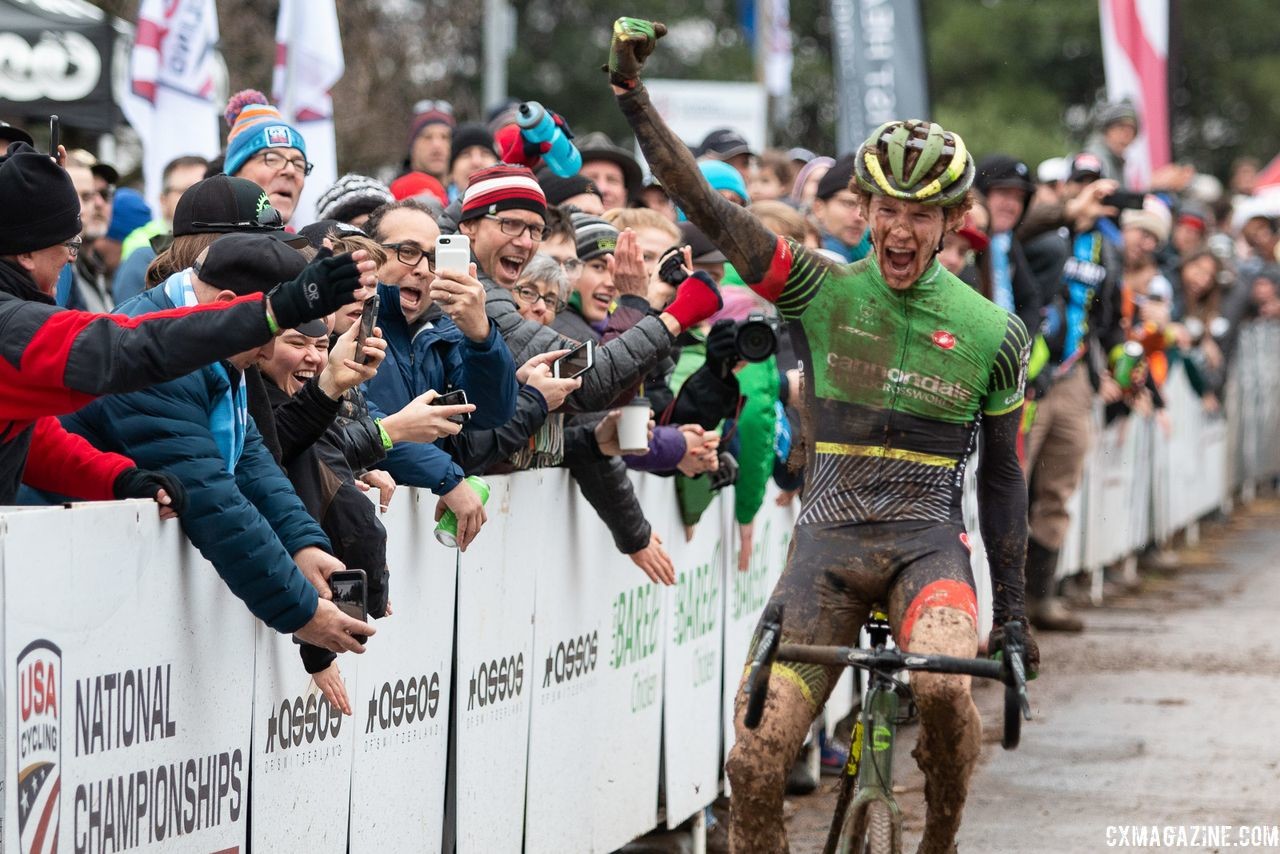
Spencer Petrov capped his first year with the team with a U23 National Championship. U23 Men. 2018 Cyclocross National Championships, Louisville, KY. © A. Yee / Cyclocross Magazine
Developing Young Talent
The Cannondale p/b CyclocrossWorld Elite team is not the only work the program is doing to support U.S. cyclocross. The program also supports a seven-rider Development program for Juniors and U23 riders.
The Development program started in 2011, and since then, it has been home to an impressive group of talented young riders.
The idea for a development program started with Chandler Delinks, one of the Masters racers who still works with the Devo program as a coach. From the original idea, the Devo program has grown to become an integral part of the team’s mission.
“We believed in it, and we just kept doing it,” Thorne said. “It was a handful of riders, and now it’s blossomed to seven development riders and a couple of coaches who help with that. It’s a cool program.”
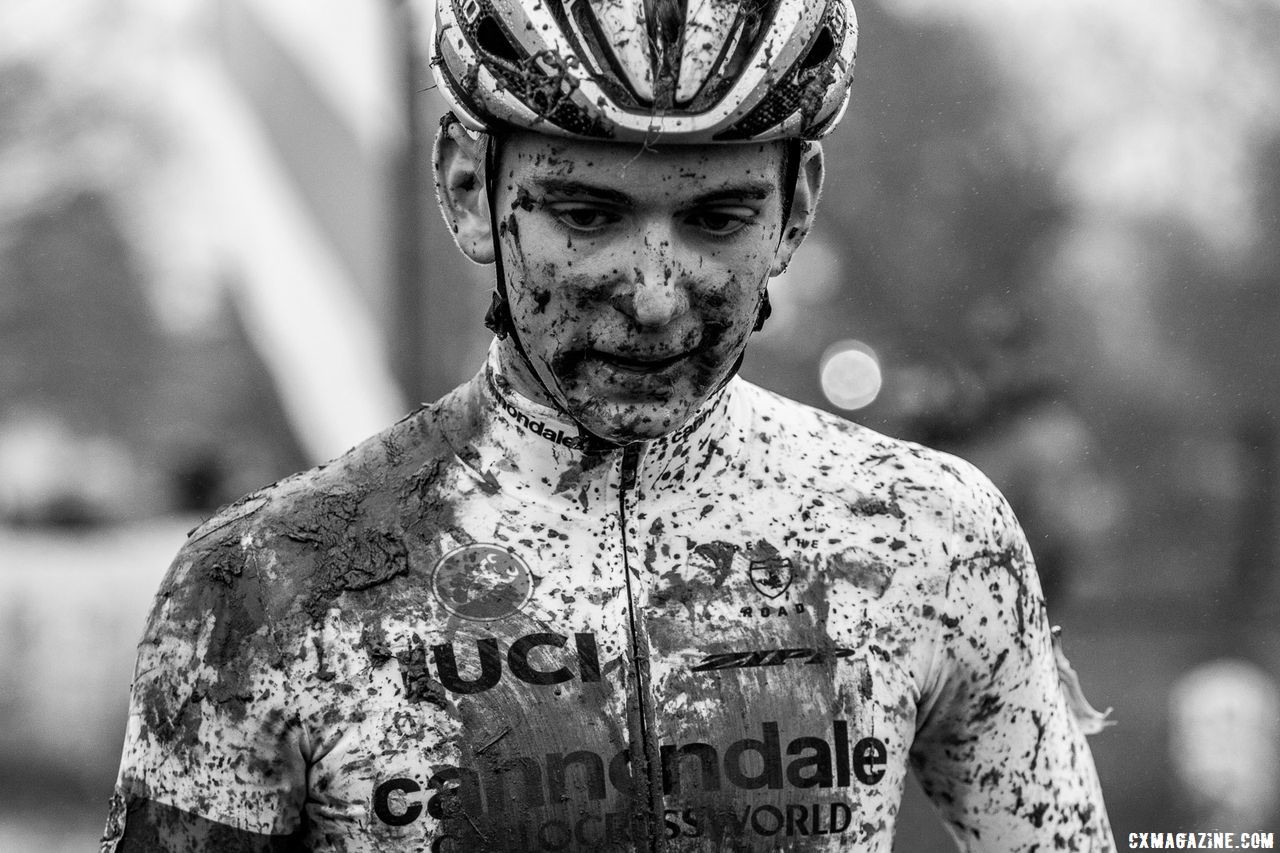
Magnus Sheffield is one of the riders in the Devo program. Junior Men 17-18. 2018 Cyclocross National Championships, Louisville, KY. © A. Yee / Cyclocross Magazine
Thorne and his team have chosen to invest in the program, but to support seven young riders, he also needed a lot of equipment. At least 14 more bikes, countless components and any number of tires. The team also needed the sponsors to buy in.
“Cannondale really jumped on board with that a few years ago, and SRAM supported it,” Thorne said. “I think it has a lot of value because it brings this program to a whole different level.”
Although Delinks was the original force behind the Devo team, the person who keeps it running today is Thorne’s “right-hand man” Mike Berry. Berry, who some readers may be familiar with from his Ask the Mechanics contributions, came aboard the program about five years ago, even though he has known Thorne for decades.
“It was one of those, hey what am I going to do in the winter?” Berry said. “Stu had sort of asked me to come help out, and I helped out a little bit and then began doing more and more stuff. You know, hey, you know how to glue tubulars, now you’re going to do them like this. Now I’m gluing pretty much all the tubulars.”
With seven riders and all their equipment under his purview, Berry has the skill set to fit the role. “We play off each other pretty well,” he said about working with Thorne. “He’s got a lot on his plate, and I’m good at organizing.”
As a mechanic, Berry is responsible for still gluing all the tubulars and maintaining the bikes as well as organizing to get athletes from across the United States to race weekends throughout the fall. Not only does the work help Berry get some money during the road offseason, it also gives him something much more important.
“It is awesome to see a kid just get it,” Berry said. “They have access to Kaitie, they have access to Stephen. There are people here who would kill for that. And these kids basically have it and they utilize it. It’s great to see them just go out for a ride with Stephen and just watch him and then try it. At first they don’t get it, but then they try again and again. They just get better. It’s awesome to see that switch get flipped.”
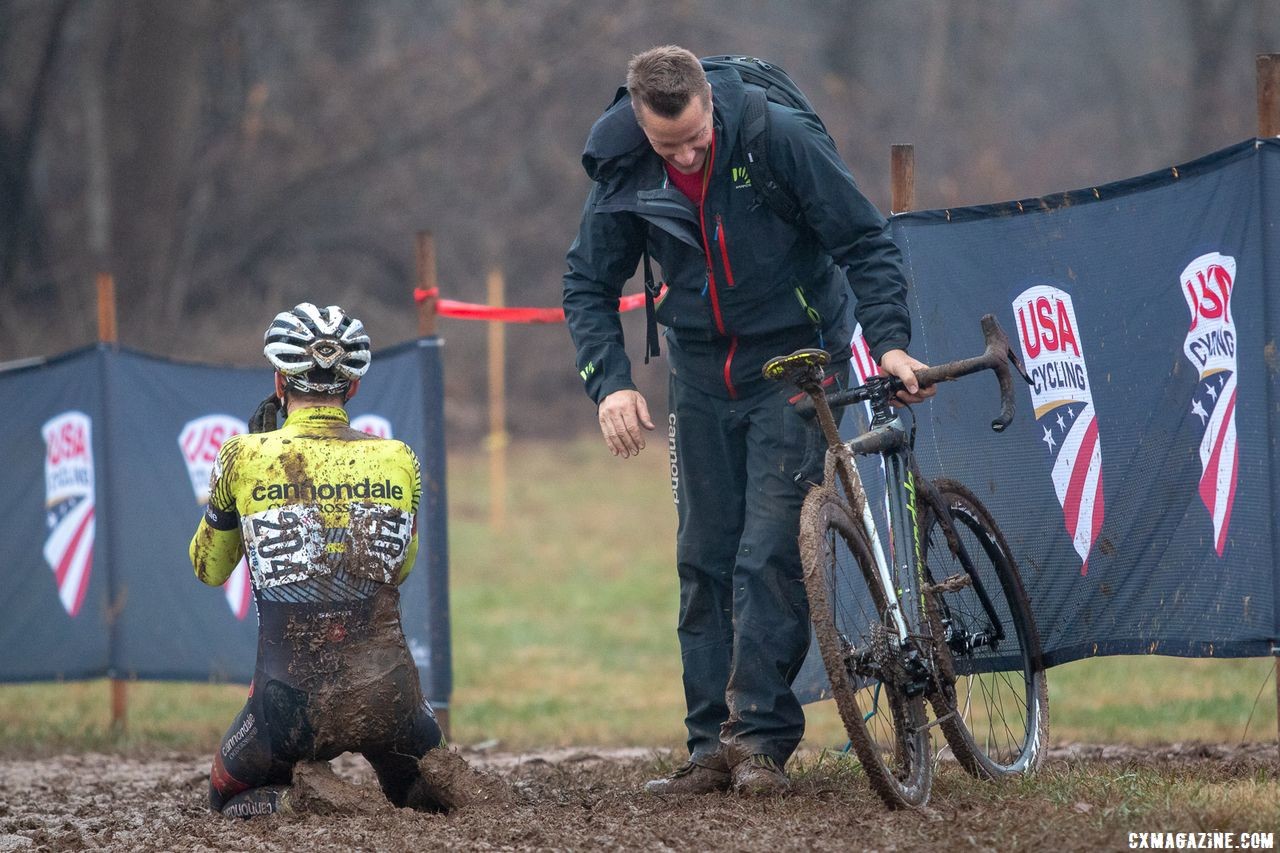
Devo riders in Thorne’s program have had a lot of success. Alex Morton recently won the Junior Men 17-18. 2018 Cyclocross National Championships in Louisville, KY. © A. Yee / Cyclocross Magazine
The program’s Devo team is a way of investing in the sport. With only four pro spots on his team—ones that rarely open up—he knows that most Devo riders’ futures will be elsewhere.
“It gives these kids an opportunity to just be sponges and get as much information as possible out of Stephen Hyde and Kaitie Keough and bring that all to their game,” he said. “If they ride for us for a year and they move on, then so be it. That’s okay, that’s what we’re here for.”
The Secret Recipe?
If building a successful cyclocross program in the U.S. were easy, we would likely see several Cannondale p/b CyclocrossWorlds supporting riders on the national landscape right now. There have been other big teams in the past decade—Rapha-Focus, Aspire Racing, Raleigh-Clement—but the Cannondale team is the one that is still going strong.
Is there a secret to the program’s success? “I don’t know what the magic is there,” Thorne said. “We just keep doing what we’re doing, and it’s worked out.”
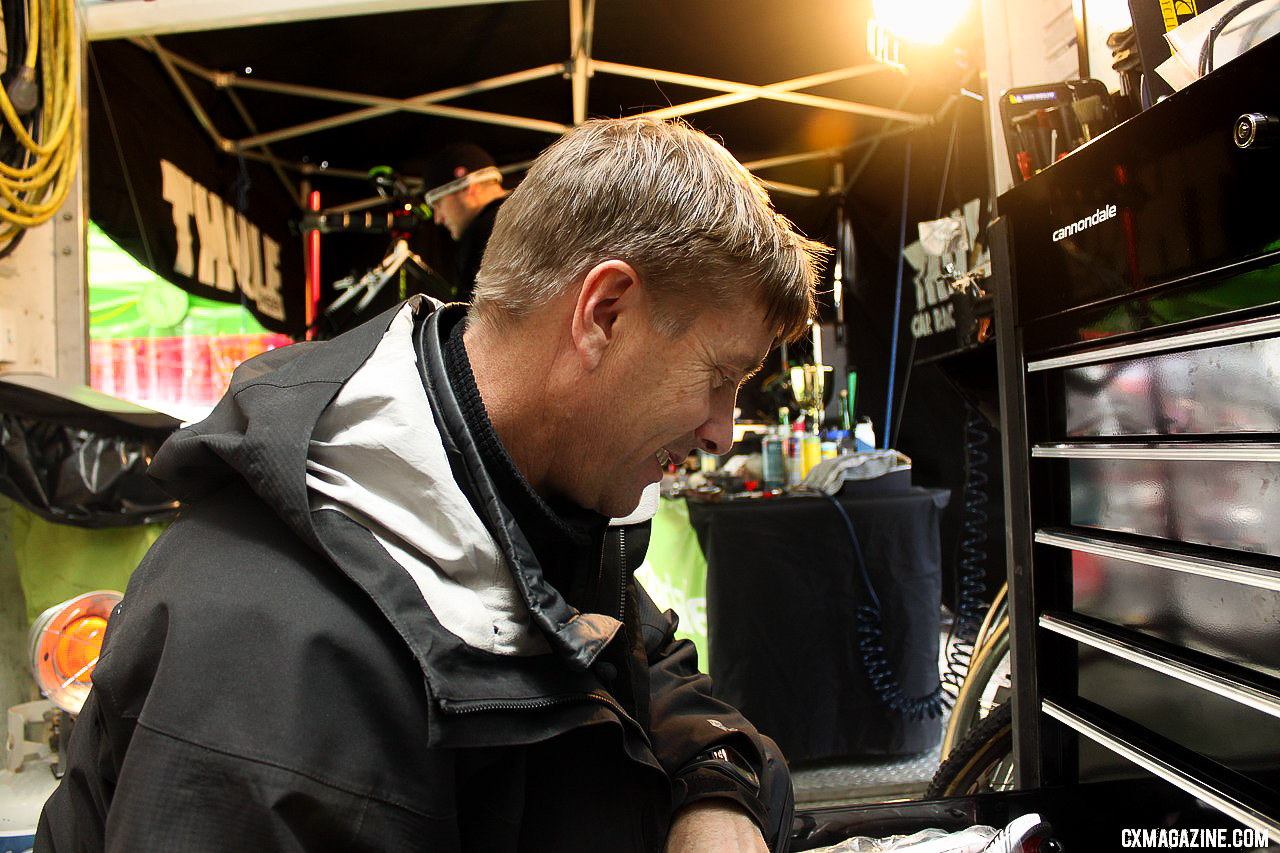
Stu Thorne working things out for the team. © A. Yee / Cyclocross Magazine
One thing that has certainly helped the program is stable sponsors. Cannondale and SRAM were with the program when it started and continue to be involved to this day.
“We’ve been lucky we’ve had Cannondale and SRAM for all these years,” Thorne said. “Their support has been incredible. I value those relationships, and I think we’ve worked really hard to keep those relationships.”
Johnson, who continues to stay involved with the program after his retirement from professional racing, echoed similar sentiments. “There’s no secret to building a successful team beyond looking for a long-term and sustainable ideal that everyone can buy into,” he said. “We have earned the support of our sponsors and are always looking for ways to give them value.”
The team’s sponsors help make sure riders are equipped for each season.
Each pro rider gets six bikes from Cannondale each year—we looked at Hyde’s full collection at the beginning of the season—as well as kits, helmets, shoes, wheels and other gear from Giro, Castelli and other sponsors. Each Devo rider gets two bikes and access to wheels each season they are with the program.
Bikes and equipment cover part of the needs for supporting a cyclocross team. There is also the money investment required to pay riders and staff and cover the cost of traveling to race weekends.
We asked about the team’s operating budget for the pro and Devo teams, but Thorne declined to comment on the specifics of his sponsorship agreements.
Some back of the envelope math shows that the cost of running a domestic cyclocross team is certainly not inconsequential for the niche sport within a niche sport. It is not WorldTour expensive, but it still costs money.
Traveling to races across the U.S. and for some, in Europe, is not cheap. Last year, Helen Wyman estimated a cost of a minimum of $30,000 to support a cyclocross rider for a season. That’s just for support, the Elites also get a salary to live on.
The team format likely brings some economy of scale, but taking that number as an estimate of the cost to support one pro rider and multiplying it by four, the cost is already well above $100,000. Added to that is the cost of traveling and lodging for members of the Devo team, the staff and other operating costs.
So what does it take to build a successful U.S. cyclocross program? Money for sure helps, as do strong partnerships with sponsors. Both are tough to find, and even if he does not have the secret, Thorne and his team have found a way to make it work.
That said, Thorne would be more than happy to share details with others interested in building a team like his. “I’m glad to see teams out there,” he said. “At the end of the day, it doesn’t cost a ton, it does cost money, but I think you add value to your team and I think you can present it as such to the sponsors.”
He also talked about the opportunities only teams can really provide to riders who want to commit to cyclocross.
“It doesn’t always work for everybody, but I think we need to try to keep these riders around as long as possible. There’s a lot of riders like Kaitie who really want to race ’cross, and she’s thinking this is a great program and as long as Stu is going to support me and I can make a living doing it, then great.”
Fostering Good Vibes
Stop by the Cannondale p/b CyclocrossWorld tent on race day, and you are likely to find a bevy of activity as racers from Juniors through Elites and even some Masters racers put their game faces on for their races.
The team is no doubt completely professional come game time, but stop by when the pressure of racing is a little less and you will find a welcoming atmosphere—and probably Mike Berry gluing tubulars.
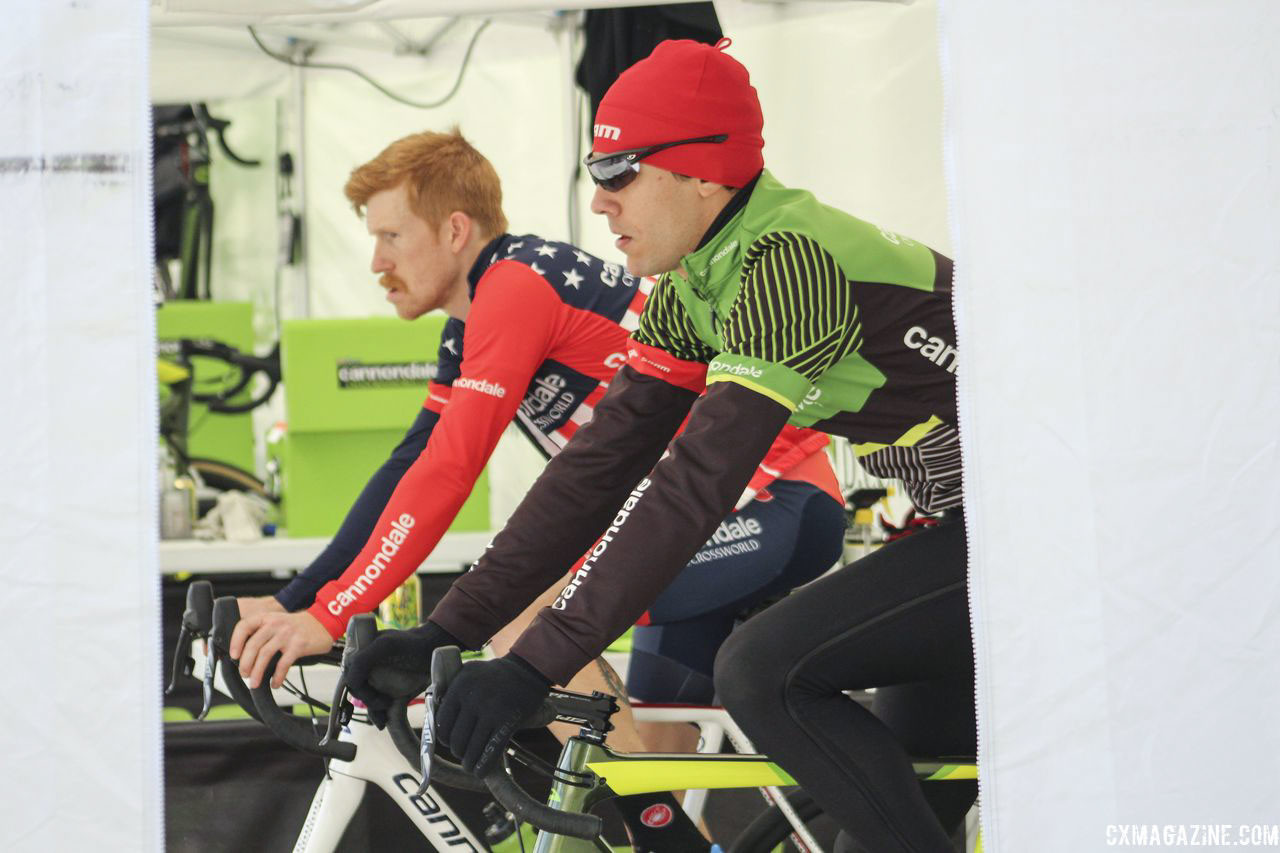
Team riders are all business when they need to be. Other times, the vibe is much more relaxed. 2018 Pan-American Cyclocross Championships, Midland, Ontario. © Z. Schuster / Cyclocross Magazine
That welcoming atmosphere is an essential part of Thorne’s vision for the team.
“It’s really about that chemistry with all of the staff and all of the riders,” he said. “It’s important to make sure it’s all running smoothly and without any issues.”
The attitude starts at the top. Despite his status on the U.S. cyclocross landscape, Thorne is a relatively hands-off team director.
“I don’t demand a lot of the riders,” he said. “I leave all the coaching up to them. I talk to their coaches every once in a while, but ultimately, I put a lot of the responsibility on them to just be honest and come to the table fully prepared. That’s kind of all I can do. We try to provide them with the best support possible.”
Although being an excellent cyclocross racer is a prerequisite to be considered for the Cannondale p/b CyclocrossWorld program, Thorne also considers how an athlete could contribute to the team vibe when evaluating talent.
“I want to be fair and equitable for everybody, but at the same time I want results and a rider who isn’t going to upset the apple cart inside the trailer,” he said.
“I’ve seen that before on teams, and even in our program,” Thorne continued. “Sometimes there’s a rider—or staff—who’s not representing themselves and the program the way you want them to. Sometimes you have to just kind of weed that out so the atmosphere under the tent is one where everyone is having a good time.”
To sum it up, Thorne was succinct, “If the vibe in the trailer is good, all is good.”
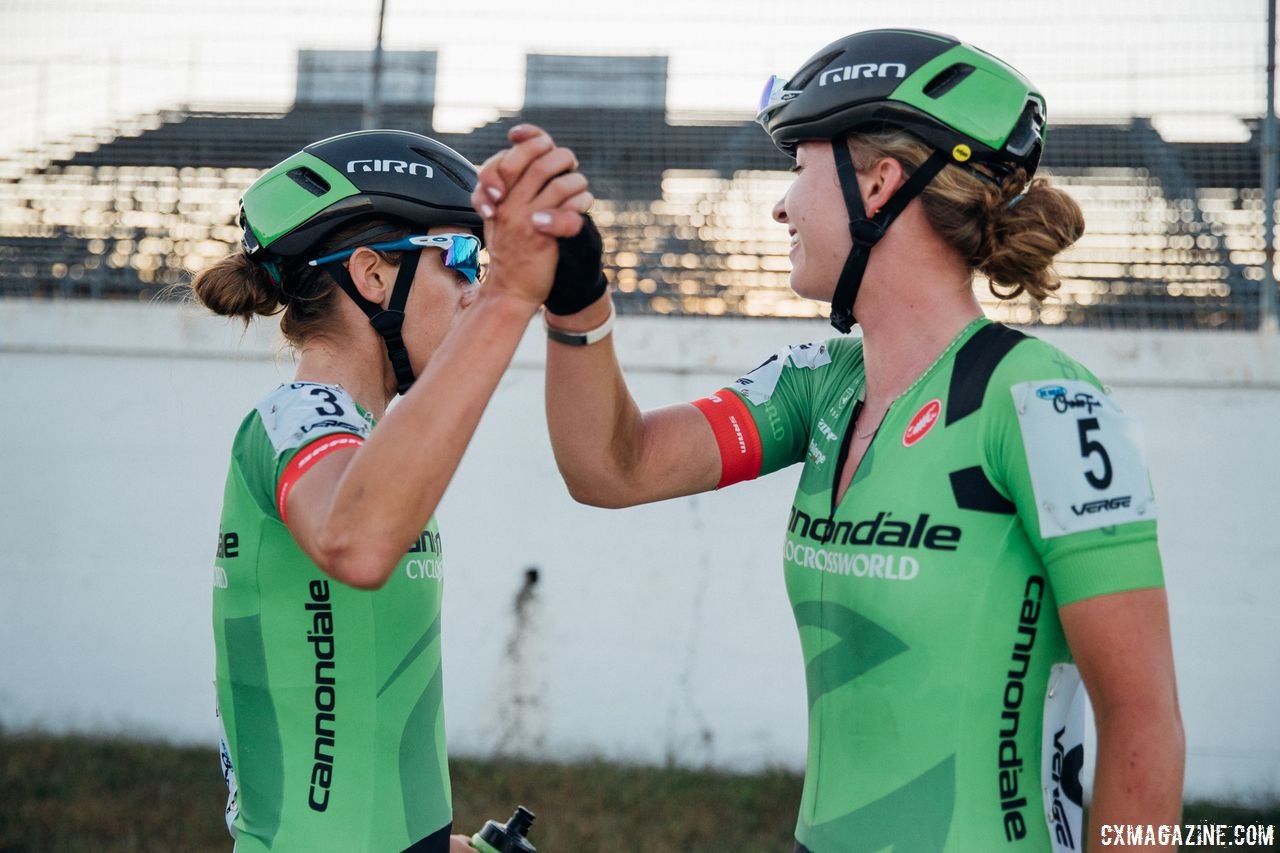
Team cohesiveness is important to Thorne and his team. 2017 KMC Cross Fest Day 1 (Friday) © J. Curtes / Cyclocross Magazine
What’s Next?
First off, the Cannondale p/b CyclocrossWorld stands to be around U.S. cyclocross for the foreseeable future.
“I don’t want to stop anytime soon,” Thorne said. “I’m in it for the long haul. As long it’s fun and we can have a good program, keep it tight, then we’re good.”
Thorne and his team have built the most successful, longest-lasting program in U.S. cyclocross. Saying the team has conquered U.S. cyclocross would be a bit off, but the team’s committed riders have accomplished a lot at the domestic level.
Right now, Keough and Hyde are in the primes of their careers, and so perhaps not surprisingly, Thorne has given a decent amount of thought to having them race in Belgium for an entire season.
“I’m not saying we’re going to do this, but it’s been tossed out there, you look at Kaitie and Stephen and if I could put them in Europe for the better part of the season, I would do that,” Thorne said.
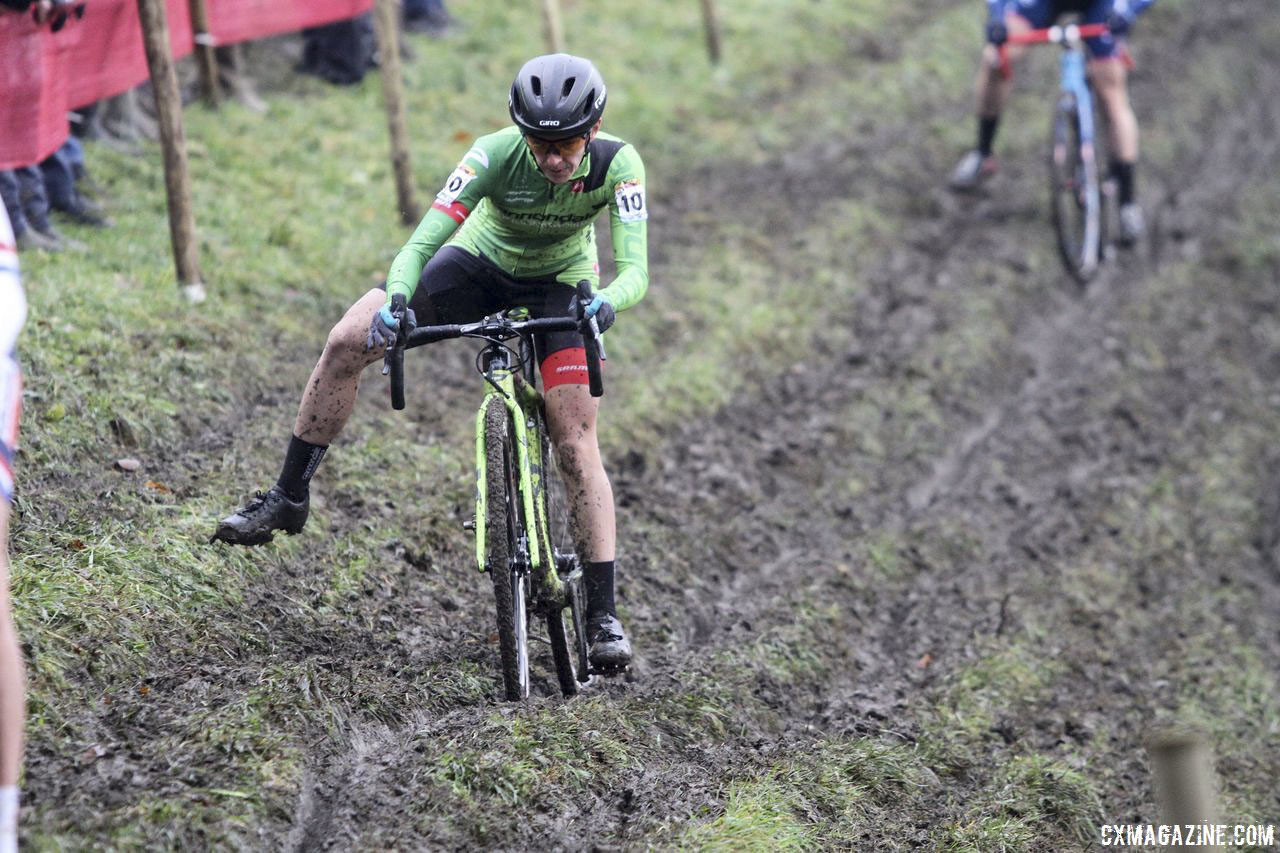
Kaitie Keough has a lot of experience racing in Europe and is in the peak of her career. 2017 World Cup Namur. © B. Hazen / Cyclocross Magazine
With her win at Jingle Cross this year and second in the World Cup overall lst year Keough has proven she can be competitive in Europe, and as Thorne said, Hyde has been knocking at the door, finishing just outside the top 10 at Namur and Heusden-Zolder last season.
In looking at the situation, Thorne highlighted some of the benefits he thinks racing in Europe could provide.
“The scene in the U.S. is great, but it can be better,” Thorne said. “We could also go to Europe with those two riders and get a lot out of it. With Kaitie finishing in the top five in the World Cups here and there, that’s a lot of value for a sponsor because all of the events [World Cup, DVV Trofee, Superprestige] can be seen in the U.S.”
During the past two seasons, Katie Compton has shown the viability of this model for athletes who can compete at the front of the races. Thorne has noticed her success.
“Compton did really well last year. She’s in the same boat with the DVV Series being live streamed by Trek, that was huge for her. I loved watching her in all those races. That was something to tune in to watch.”
Another reason Thorne is looking at Europe? Traveling in the U.S. is expensive!
With most Belgian cyclocross races located in Flanders at most a few hours from one another, supporting his riders in Europe would be much easier than repeatedly flying them across the ocean to race World Cups before returning back to the U.S.
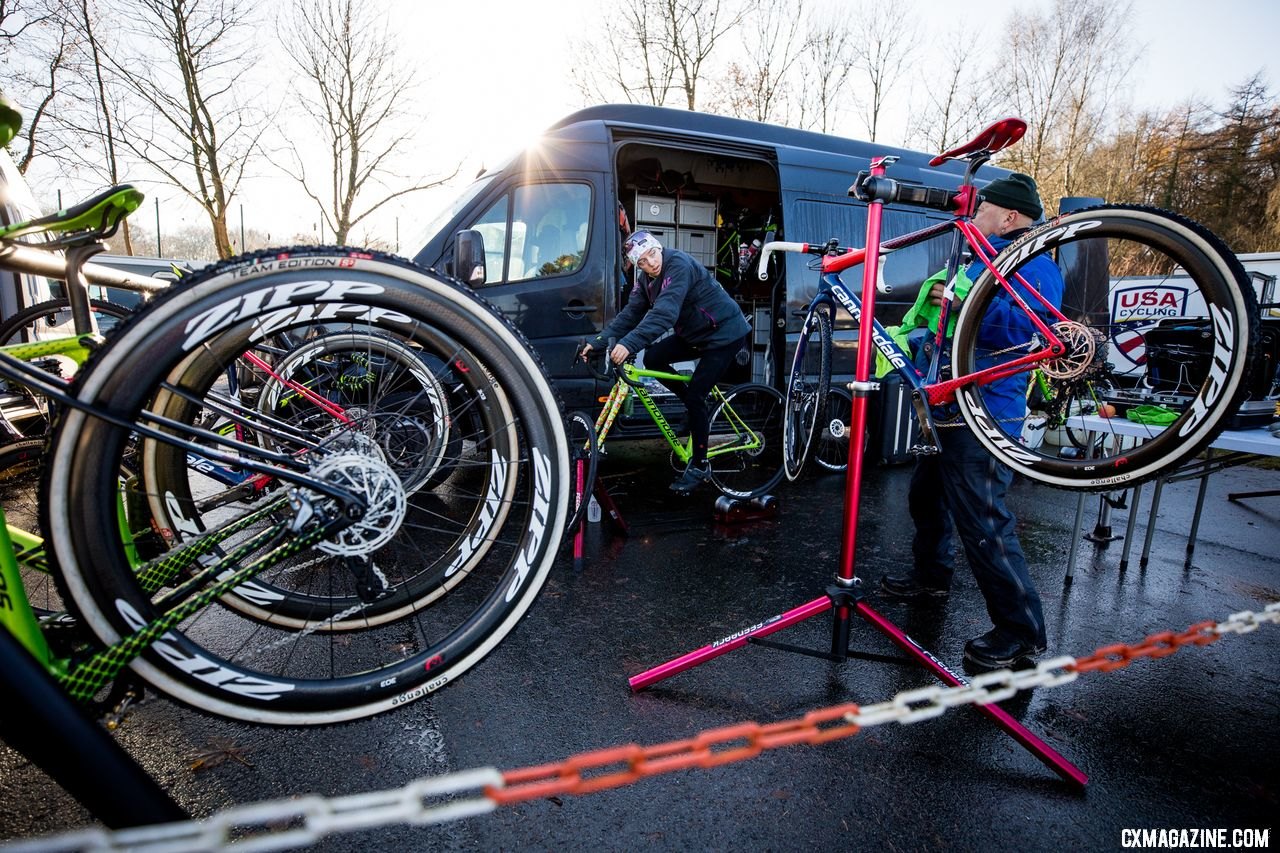
The Cannondale p/b CyclocrossWorld program has shown it can support riders in Europe. Elite Women, 2017 Zeven UCI Cyclocross World Cup. © J. Curtes / Cyclocross Magazine
When I turned my recorder off, Thorne continued to shared stories of Tim Johnson, Lyne Bassette and him traveling across Europe in a rented van to race cyclocross in the 1990s. If Cannondale p/b CyclocrossWorld does choose to run a European program, Thorne is hoping for a bit more stability than those much more adventurous days.
“It’s really important to make sure your situation in Europe is quality,” he said. “USA Cycling has a beautiful facility over there. We pay to use it, but it works for us. It’s a good place to be. We have the infrastructure, it’s just if we decide to do it or not.”
Will Europe happen? That remains to be seen.
What is certain is that Stu Thorne and his team have built something special within U.S. cyclocross. The combination of his team, sponsors and the athletes show the benefits large teams can provide for developing and getting the most out of cyclocross talent.
It would be great is U.S. cyclocross had five more teams exactly like Cannondale p/b CyclocrossWorld, but for now, it serves as a lesson of the factors that need to come together to build a successful program.

